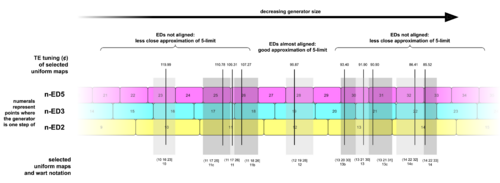Uniform map
A uniform map is any near-just map found by uniformly multiplying every entry of the just intonation point (JIP) ⟨log₂2 log₂3 log₂5 ...] by some value before rounding it to integers.

For example, choosing 17.1 as our uniform multiplier, we find the map 17.1⟨1 1.585 2.322] = ⟨17.1 27.103 39.705] which rounds to ⟨17 27 40]. This is one of the many uniform maps for 17-ET, and every ET has many possible uniform maps.
To find a uniform map for n-ET, choose any multiplier that rounds to n. For example, 16.9 rounds to 17, so we could use that to find another example for 17-ET. Uniformly multiplying 16.9⟨1 1.585 2.322] = ⟨16.9 26.786 39.241], which rounds to ⟨17 27 39].
Integer uniform map
A uniform map whose multiplier is an integer is called an integer uniform map. For example, we could use the integer 17 itself directly. So 17⟨1 1.585 2.322] = ⟨17 26.944 39.473], which also rounds to ⟨17 27 39].
Simple map
Every integer uniform map is also a simple map, and vice versa. These are identical objects. The two different terms provide two different ways of presenting about the same object, which can be helpful in different contexts:
- In contexts pertaining to tuning accuracy, "simple map" works great. It conveys that this map is not necessarily the best map — i.e it may not be the most accurate tuning overall — but it is still good, owing at least in part to its simplicity. The classic example of a best map which is not the simple map is 17c in the 5-limit, ⟨17 27 40], the one we found as the uniform map for 17.1; when we consider the error across all three of the primes here, the best position for the vertical line in the uniform map continuum happens not to run through the same cells as the cells that the line running directly through the 17 in the row for n-ED2 runs through. For more information on this, see: Douglas_Blumeyer's_RTT_How-To#A_multitude_of_maps.
- In contexts pertaining to other uniform maps, "integer uniform map" works great. This is probably the less common context between the two, and so one should expect to find "simple map" occur much more often.
A uniform map is the same thing as a generalized patent val, or GPV.
An integer uniform map (or simple map) is the same thing as a patent val.
There is no difference between "val" and "map" in most RTT cases; this is discussed here: Val#Vals_vs._mappings.
Otherwise, the difference in terminology between uniform maps, integer uniform maps, patent vals, and GPVs, reflects an inversion in conceptual framing. For patent vals and GPVs, patent vals are considered the base case, and GPVs a generalization thereof, whereas for uniform maps and integer uniform maps, uniform maps are considered the base case and integer uniform maps a specification thereof.